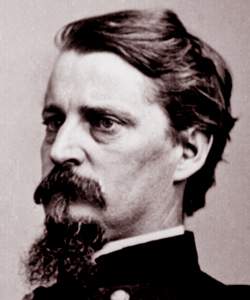Winfield Scott Hancock (American National Biography)
Scholarship
Following his marriage [in 1850], Hancock served at several posts, including Fort Leavenworth, where his regiment calmed disorder in "Bleeding Kansas," and in Utah, where the "Mormon War" ended before the Sixth Infantry arrived. At the outbreak of the Civil War, he ranked as captain and served as chief quartermaster, Southern District of California.
Appointed brigadier general of volunteers as of 23 September 1861, Hancock served in Major General George B. McClellan's (1826-1885) Army of the Potomac. After the battle of Williamsburg (5 May 1862), the first in which Hancock fought, McClellan referred to him as "superb," bestowing a nickname that Hancock retained. At Antietam (17 Sept. 1862), Hancock commanded a division and won promotion to major general. Distinguished service at Chancellorsville (1-4 May 1863), where he conducted a stubborn rearguard action that saved a demoralized Union army from total destruction, advanced Hancock to corps command on the eve of Gettysburg. There he assumed command of the entire army late in the first day of battle before the arrival of Major General George G. Meade and placed Union forces in a strong defensive position on Cemetery Ridge. Hancock's II Corps fought valiantly on all three days (1-3 July). On the second day, Hancock redeemed the blunder of an advance by Major General Daniel Sickles and stabilized the left center before confederates could turn the Union flank. Severely wounded in the thigh on the third day, Hancock refused to leave the field until his troops had repulsed Confederate General George E. Pickett's charge. Gettysburg marked the zenith of Hancock's military career.
Appointed brigadier general of volunteers as of 23 September 1861, Hancock served in Major General George B. McClellan's (1826-1885) Army of the Potomac. After the battle of Williamsburg (5 May 1862), the first in which Hancock fought, McClellan referred to him as "superb," bestowing a nickname that Hancock retained. At Antietam (17 Sept. 1862), Hancock commanded a division and won promotion to major general. Distinguished service at Chancellorsville (1-4 May 1863), where he conducted a stubborn rearguard action that saved a demoralized Union army from total destruction, advanced Hancock to corps command on the eve of Gettysburg. There he assumed command of the entire army late in the first day of battle before the arrival of Major General George G. Meade and placed Union forces in a strong defensive position on Cemetery Ridge. Hancock's II Corps fought valiantly on all three days (1-3 July). On the second day, Hancock redeemed the blunder of an advance by Major General Daniel Sickles and stabilized the left center before confederates could turn the Union flank. Severely wounded in the thigh on the third day, Hancock refused to leave the field until his troops had repulsed Confederate General George E. Pickett's charge. Gettysburg marked the zenith of Hancock's military career.
John Y. Simon, "Hancock, Winfield Scott," American National Biography Online, February 2000, http://www.anb.org/articles/05/05-00313.html.




